From high-level strategy to tactical implementation guidelines, here you will find everything you need to know about successfully and efficiently managing Windows-as-a-Service upgrades, Microsoft 365 Apps for enterprise client rollouts, hardware refreshes, app rollouts, and other continuous upgrade projects.
Need a quick summary? Please read this section. For the full version, you can use this section as a Table of Contents.
What is Evergreen IT Management? The term "Evergreen IT Management" refers to a new IT management approach that focuses on continuous and incremental improvement rather than larger one-off transformation projects done sporadically. While Evergreen IT means many things to many people, Juriba's Evergreen IT Management focuses on End User Technology (EUT), End User Computing (EUC), and the Modern Workplace.
Why should you care? The digital transformation ability has become a necessity for survival rather than a nice-to-have competitive advantage. Executive management is relying on IT to not only technically enable this change but be a driver of innovation and transformation. Only Evergreen IT Management provides you with the agility and scalability required to achieve this feat.
How is it different from traditional IT Management? Until recently, end-user IT change was managed as a series of large projects using manual spreadsheets, hand-cranked databases, color-coded Gantt-Charts, and large amounts of resources. However, the velocity of technology is rapidly increasing, and traditional IT management methodology cannot keep pace. The most significant difference between the old way of doing things and Evergreen IT Management is that the new approach focuses on continuously upgrading, improving, and updating every aspect of your IT environment within set timelines.
More predictable budget and capacity management.
What strategic considerations do you need to think about? Once an industrialized, scalable, and repeatable process is established, your Evergreen IT Management will run like a well-oiled machine. However, like any larger project, it requires you to create a strategic road map and an implementation strategy plan that includes internal change management, process optimization, and technology upgrades, as well as application management considerations.
How do you practically implement Evergreen IT? Since every organization is different, each Evergreen IT Management approach will be unique. However, there are tried-and-true processes like Microsoft's Windows 10 Deployment Ring Concept or Juriba's Evergreen IT Management process based on industry best practices.
How do you get started? The best way to get your Evergreen IT Management off the ground successfully is to create a business case and get executive buy-in. Once you have met these fundamental milestones, it is time to download our customizable project plan template to create your repeatable and scalable process. Finally, set up your Evergreen IT Management tooling and you are all set!
The purpose of this page is to give you all the essential information to start planning and implementing Evergreen IT Management. Below, we will define this new IT management methodology, take a closer look at the benefits, and give you some tried-and-true advice on the essential strategic considerations and tactical implementation advice from our Evergreen experts. We will finish by outlining some of the most common pitfalls and challenges and give you practical tips, resources, and best practices to get you started immediately.
We know this document cannot replace a personal conversation, but we hope it inspires you to get started and gives you a head-start!
The COVID-19 pandemic was devastating in terms of health and economy but also had a positive if unexpected side effect. It was a huge wake-up call for many organizations who quickly realized that Digital Transformation is no longer optional but has become mandatory overnight. As the world scrambled to adjust to the new life working from home under lockdown, companies found innovative ways to sell their services or products, continued to provide the best customer service they could, and ensured they would emerge from the crisis alive (or even stronger than before). Here is where the cream separated from the crop. An easy example was restaurants. Some turned to social media with pleas to rally community support. In contrast, others thrived because they stopped, re-evaluated, and innovated, e.g., by providing produce boxes or speedy no-contact food delivery.
During the pandemic, we had a front-row seat to watch certain companies adjust at lightning speed while others struggled. The deciding factor was their ability to transform quickly enough digitally. To better visualize it, imagine driving Digital Transformation as steering a vessel through an ever-changing storm out on the open sea. Clunky large vessels make navigating stormy waters very difficult. In other words, traditionally inflexible companies that are deeply embedded in legacy systems and outdated processes are moving too slowly to adapt to the fast-moving customer demands and are quickly out-performed by often smaller, leaner, and more agile competitors.
To make matters worse, some organizations reverted back to more familiar yet ineffective methodologies, putting Digital Transformation efforts on hold during a crisis. While this reaction was understandable as it followed normal human behavior, it was much more beneficial to stick to or, better yet, accelerate your Digital Transformation plans. As previous crises have shown, companies that cut costs and scaled back on innovation during hard times experienced more competitive pressure than companies that took a more proactive approach.
Although the current circumstances put more pressure on organizations to move faster on implementing this new IT management methodology, Evergreen IT Management also has tremendous benefits during normal business operations. Today, modern IT teams face numerous challenges: managing more complex IT environments while driving innovation with fewer hands and stagnant or only marginally increasing IT budgets. Extra pressure is added by the ever-increasing velocity of IT change, constantly changing business requirements and customer expectations, Shadow IT and resulting application sprawl, and growing security concerns.
Evergreen IT Management empowers IT departments to overcome these specific challenges by:
[You can find more detailed information in our article "Why Evergreen IT Must Be Part Of Your Long-Term IT Strategy".]
Evergreen IT Management is one of those crucial initiatives that not only will cut costs, free up much-needed resources, and increase your IT resilience but will also boost your organization's agility to adapt to whatever changes are coming your way.
For example, for your hardware, this means that every piece of physical equipment is kept within warranty or lease and is refreshed on a fixed timeline. For your operating system, this could translate into never being more than two versions behind the latest Windows 10 release. Achieving this level of change management requires an industrialized process for procurement, licensing, scheduling, communications, and deployment that is not only scalable but also highly automated and repeatable.
Most commonly, Evergreen IT is implemented for the following use cases:
Now that we have defined Evergreen IT, it is important to contrast it with traditional IT management in order to understand how it compares.
|
Traditional IT Management |
Evergreen IT Management |
|
|
Goal & Premise |
Primarily focuses on maintaining status quo ("Keeping the Lights On") with planned multiple-year big-bang IT transformation cycles. |
Continuously improves the health, security, and stability of an IT environment through small and incremental upgrades. |
|
Example of Scope |
Windows migration project, one-off hardware refresh, email or VoIP system upgrade. |
Continuous, lifecycle-based Windows-as-a-Service, Microsoft 365 Apps for Enterprise updates, hardware upgrades. |
|
Methodology |
Resource driven with inadequate project management methodologies (e.g., Waterfall) and visualized with Gantt Charts. Not based on real-time data. |
Automated, with scalable, repeatable, and agile project delivery processes. Relies on data and automation to determine path of maximum velocity and delivery efficiency. |
|
Tooling |
Often with dozens or even hundreds of outdated spreadsheets and hand-cranked databases. |
Evergreen IT project management tool with central command & control, automated email and self-service capabilities, and the ability to run multiple projects in parallel. |
|
Budget |
Separate and dedicated budgets for innovation or transformation initiatives. BAU "lights on" budgets set to maintain the status quo. |
Consistent stream of budget dedicated to IT management and improvement. Leaves room for project-based innovation budget. |
| Benefits |
|
|
| Disadvantages |
|
|
Real-World Benefits Of Evergreen IT Management
According to Flexera, "companies are wasting 30-35% of their cloud and software spend," i.e. spending money on duplicate and redundant apps. Our experience shows that customers who embrace Evergreen IT Management consolidate as much as 30-40% of their overall application portfolio after normalizing and rationalizing — significantly reducing the associated licensing costs and maintenance efforts.
Until now, successfully implementing Digital Transformation meant a competitive advantage — now it means survival. By embracing Evergreen IT Management, you can streamline, automate, and accelerate your IT management, making you more nimble and agile to respond faster and with more impact to market changes. For example, rolling out a new application in days, not weeks.
On average, IT issues cost enterprises and other large organizations about $60 million every year. However, the vast majority of damage is caused by the resulting loss of productivity. Contrarily, a great employee experience reduces turnover and increases motivation. In a 2019 Deloitte report of employees, 88% responded that this was a critical issue for them.
With a centralized command and control platform, you understand (at any time) what needs attention, what has been upgraded, and where there are potential issues. This positions IT as a customer-oriented service provider and reduces or eliminates Shadow IT issues, i.e. application sprawl, license compliance, data loss, shelfware, etc.
Traditionally, up to 80% of the IT budget was earmarked for simply "Keeping The Lights On" and the rest had to pay for any upcoming IT Transformation project. Innovation took a back seat. But as usual, IT has to do more with less. Evergreen IT delivers a multitude of resource and tangible asset savings that can be used to invest elsewhere.
IT budgets and capacity availability have always been majorly impacted by large IT projects, i.e. Windows 7 to Windows 10. But these projects often went over time and over budget. As part of a well-managed Evergreen IT process, you can exactly say, at any given point in time, what spending will be next week, in three months, or for the entire year to keep you in lifecycle.
Creating an Evergreen IT strategy happens in two steps: 1) creating your strategic implementation framework (your theoretical plan) and 2) carefully crafting your implementation plan. Let's walk through both phases now:
Just like any project worth doing, successful Evergreen IT Management takes careful planning. We recommend breaking down your planning into three phases:
Let's look at each phase and the associated steps in more detail.
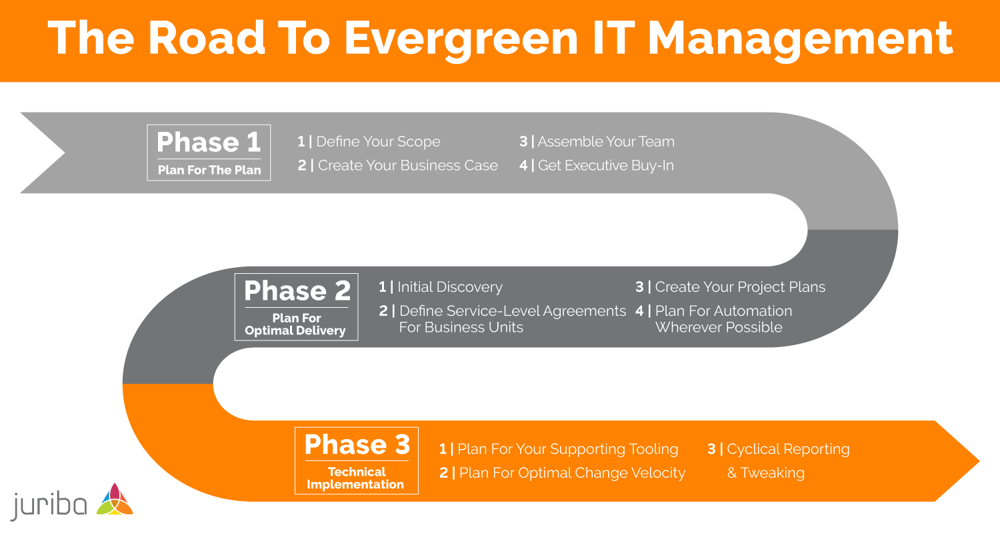
While it might sound like tedious busywork or even overkill, this initial planning is essential to the success of your project. Skipping it will result not only in inefficiencies later on but in budget and timeline issues as well.
Start by defining the scope of your Evergreen IT project. This might sound a little counter-intuitive because Evergreen IT is a continuous stream of updates but it isn't an all-or-nothing deal. Scoping helps to visualize it as a string of never-ending mini-projects. If you are new to this, we recommend that you define your overall vision (e.g., 5-year roadmap) and break it down into manageable chunks. For example, tackling your Windows-as-a-Service updates first is a great start. Then add on your Microsoft 365 Apps for Enterprise client rollout. Or look for quick wins with already relatively established processes (i.e., hardware refresh) as a starting point.
Next, you will want to define your business case to get your budget and resources approved. If you do not know how much an upgrade cycle will cost you, orient yourself on industry reports like Gartner's estimate of $77/device for unmanaged environments versus $43/device for locked and managed environments if you are running an update once a year. Be sure to understand the parameters to be able to estimate your fully-loaded costs. Also, feel free to check out these 25+ Evergreen IT Management stats that might be helpful in compiling your business case.
Once completed, you will need to assemble your core team. If you are a larger organization, plan on having at least one full-time project manager.
Finally, you will need to get executive buy-in. This is absolutely crucial. Without your executive management on board, you will not be able to make the organizational and process changes required to be successful. For ideas and advice on how to do that, check out "How to get your executives fired up about Evergreen IT".
Once you have your plan, resources, budget, and executive buy-in, it is time to roll up your sleeves. Start by assessing the current state of your environment in an initial discovery phase. Be sure to get a clear picture of the stream of BAU updates (e.g. hardware break/fix events), what is out of sync and why, and the volume of assets in scope. Next, build out your high-level process plans and define how you will interact with your business units to get it done as part of service delivery expectations.
Now, create your implementation project plan. Remember, the goal is to create a highly automated, scalable, repeatable, and industrialized process, so it is advisable to create a project plan template that can be easily customized for each project. I highly recommend that you download our fully-customizable Evergreen IT Management Project Plan Template that includes hundreds of action items and is based on readying millions of devices for upgrade or migration. Then simply customize it to your needs.
Finally, to streamline and accelerate your process in order to keep pace with the velocity of change needed, you will need to automate as much as possible. Look for manual labor-intensive tasks, such as email communication, scheduling, and more.
Now is the time to plan supporting tooling with which you will manage your workflows, put everything in place to maximize your change velocity, and get reporting right. We will discuss in more detail below how to automate your update processes by using our Dashworks product, but you might find it helpful to check out the Tool Requirements For Optimal Windows-as-a-Service Management as it applies for Evergreen IT as well.
You will not be able to keep up with the necessary changes and updates if you simply go about your update processes as you did before. Rather than phasing your rollout by department or location, look for ways to accelerate it through mathematical algorithms, e.g., test the best applications first for maximum deployment velocity (more on how to do this below). Finally, be sure to have repeatable reporting and dashboarding to keep track of all your moving parts as well as a checkpoint to tweak your process as needed on an ongoing basis.
Now that you have your theoretical plan in place, you can take the steps required on an organizational, process, and technology level to set yourself up for long-term strategic success.
Honestly, getting your organization on board and excited about Evergreen IT as well as following through with the internal changes that need to be made is probably the hardest part about Evergreen IT Management. However, one of the most fundamental milestones for organizational change is getting executive sponsorship — without it, your Evergreen IT strategy simply won't happen.
Secondly, everyone involved, whether a stakeholder or a team member, needs to understand the business case for implementing Evergreen IT, including the scope, budget, and resource requirements, and your delivery strategy before pushing for internal change. This will impact:
For the success of your Evergreen IT Management, it is crucial to automate processes as much as possible. You might be looking at thousands of processes, so rather than boiling the ocean, it is crucial that you find the ones that have the largest volume and require the most manual input for your most pressing use case. For example, creating an order for a new laptop. They are often highly repeatable. It seems obvious, but by prioritizing these first, you will be able to achieve the quickest wins.
Then tick each process off one by one. While this might seem overwhelming at first, remember that there will be overlap between use cases, so the subsequent use cases will be easier and faster.
To start, review each business process to determine where you can be more strategic, meaning where can you optimize your processes to be as repeatable and scalable as possible. Once you have reviewed your standard processes, you will need to look at the exceptions. For example, while the hardware program timeline for Germany might be T-30 days, in Argentina you might be looking at T-60 days because the hardware might take longer to get delivered.
A few tips to make this step more effective:
Once you have defined and optimized your processes, it is time to review the quality of the data, technology, and tools that you have in place to support these processes.
This doesn’t require anything fancy. However, you will need a real-time centralized feed of your standard data sources, such as your SCCM, Active Directory, and Microsoft Desktop Analytics, as well as other Microsoft Endpoint Manager data inputs, Exchange, Office 365, HR feeds, and others.
Next, identify any existing project support toolsets you already have in-house, such as any:
Once completed, assess your tools against your Evergreen IT Management tooling requirements to identify any possible gaps. As you do so, consider which of these are strategic tooling options and which are best-in-class point solutions. This is probably the most difficult part of this process and the trick here is to figure out which tools you will need for which scenario and which data is required to support it.
While the tool requirements are slightly different depending on the use case you are working on, we have compiled a list of steps to building an optimal tool stack for Evergreen IT Management and created a list of tooling requirements for managing an effective Windows-as-a-Service upgrade process. You can use this as inspiration, but of course, as you look at other use cases, you will need slightly different tools, e.g., for your Microsoft 365 Apps for Enterprise Client Rollout you will want to look into the Office readiness toolkit.
Finally, consider how it will impact other areas of your technology landscape. For example, consider how Evergreen IT will impact your legacy applications.
Eventually, successful Evergreen IT Management means organizations will run Microsoft 365 Apps for Enterprise and Windows 10 upgrades, hardware refreshes, new application rollouts, and many other continuous transformation streams in parallel. Many of these rollouts will require a large number of applications to be tested, and possibly re-packaged and re-tested, over and over again. In fact, according to a recent Juriba survey, 89% of our customers identify application compatibility as their top bottleneck in their Evergreen IT Management process, especially when looking at Windows 10 Servicing, because testing and packaging is expensive and takes very long. The average spend for application packaging and smoke testing per app per annum is $680 (£510) at time of publishing and customer data has shown that it can take as much as 100 man hours to manually take a single application from initial request to end user deployment!
Often, application management is delivered by a siloed-off traditional application packaging and testing team supported by little or no automation. Quickly, work can come to a standstill as the team is overloaded trying to manage the volume of change, leading to increased risk (not getting it done), increased spend (or you will get stuck), and increased headcount (to get back on track). But in the long term, your application management function must change in line with everything else:
While this list is certainly not exhaustive, it provides you with a strategic high-level overview of what changes need to be made in order to run an Evergreen app management process successfully. After we talk about the practical Evergreen IT Management process, we will also look at Evergreen Packaging and Smoke Testing in practice.

One of the biggest struggles IT teams encounter when embracing Evergreen is creating the actual process for their unique environment. One size definitely does not fit all here, even if many of the processes are relatively similar in nature.
Your exact process and workflows heavily depend on the state your IT estate is in, the type of applications you have in-house, and many other factors. But there is a tremendous value to looking at already established processes, adjusting and adapting them to your situation, and customizing and improving where needed.
There are two very useful concepts that were developed for Windows 10 Servicing Management. It is not only helpful to understand the general concepts but you could reuse them by making certain adjustments to implement all Evergreen IT use cases.
The first concept is called Windows Deployment Rings which refers to Microsoft's recommended approach for managing Windows 10 Servicing updates. While it is inherently designed for Windows 10 updates, the high-level methodology can be used in any Evergreen IT update scenario.
In 2015, Microsoft migrated 90,000 employees within a matter of weeks rather than years using this concept. Since then, it has undergone several cycles of changes and improvement. Microsoft defines deployment rings as follows:
Deployment rings in Windows 10 are similar to the deployment groups most organizations constructed for previous major revision upgrades. They are simply a method by which to separate machines into a deployment timeline. With Windows 10, you construct deployment rings a bit differently in each servicing tool, but the concepts remain the same.
Each deployment ring should reduce the risk of issues derived from the deployment of the feature updates by gradually deploying the update to entire departments. As previously mentioned, consider including a portion of each department’s employees in several deployment rings".
Essentially, the principle is that you start rolling out the Windows Insider for Business version of the new Windows 10 update to very few "Explorers" before the official update is available. This allows you to test-drive new features. Once the new Windows version is released to manufacturing (RTM), you start rolling it out to Test Pilot groups. The first group is much smaller and only covers limited hardware and application choices while the second group will test most hardware models and all important business applications 30 days later.
These test pilots pave the way for broad deployments organized in waves. Depending on your organization, you might only need two waves, but if you are larger you might want to use more. Finally, any difficult stragglers as well as VIPs are migrated to close out the project.
In a general context, deployment rings can be used for all Evergreen IT use cases, e.g., for managing a hardware refresh or transition to Virtual platforms. You simply have to adjust the parameters and enrollment criteria.
The most frequently asked question we get about deployment rings is whether it matters how many people are in each ring and how should they be selected. While you could seek out, let's say, 5% of your IT team as volunteers for the first test pilot and a certain number of friendly users from business units, it is much more efficient to mathematically determine who and how many people you need to add for each phase based on critical readiness and application coverage criteria.
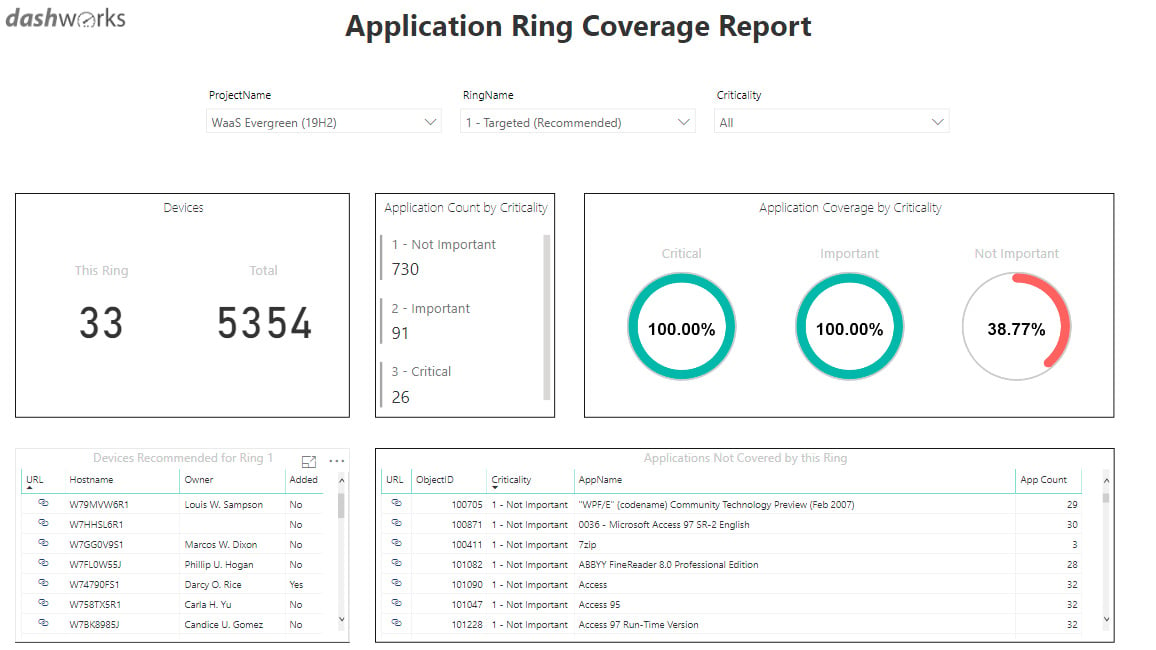
By strategically selecting your test ring participants, you will achieve the fastest coverage area. If this is something you are struggling with, we highly recommend that you read our article on "How We Mathematically Calculate Deployment Rings For Maximum Velocity" but we will cover the basics below.
When following the process laid out by the Windows Deployment Ring concept above, there are many practical concerns you will have to consider when planning for an optimal Evergreen IT Management process. Essentially, you will want to look at all of your in-scope elements and then determine which factors are your bottlenecks. For example, for a Windows 10 Servicing project you will need to determine which applications need to be tested or remediated first to be able to cover the largest user base possible to move your migration along as fast as possible.
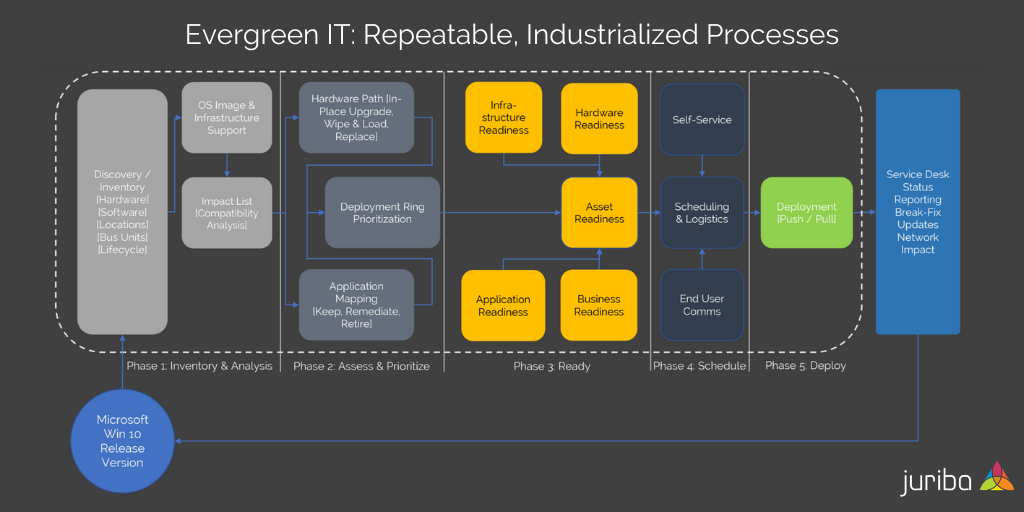
The graphic lays out the five basic steps on how to do that using the example of a Windows 10 Servicing project, but this Evergreen IT process framework can be used for all use cases:
In this first step, you are running through your discovery and inventory process. Depending on which use case you are working on, the elements you are looking at will differ. For example, for a hardware refresh, you are interested in knowing your device's warranty or lease dates, whereas for an application life cycle project you will need to know how many different applications and application versions are currently installed in your environment, what the usage of those apps is, and so on. Essentially, this step allows you to gain a clear understanding of what the exact scope of the project is.
Now that we know the scope of your Evergreen IT cycle, it is extremely useful to first assess and prioritize your next steps before diving right in. For example,
For a Windows 10 to 10 upgrade, you want to know if you have enough disk space on the hardware to receive the upgrade, whether all of the drivers on a particular machine are going to work, and whether your applications are compatible for the upgrade.
For a hardware refresh program, you would look at the warranty dates and lease dates of all devices to determine which devices are due to be refreshed and therefore in scope.
For a mobile OS upgrade cycle, you will look at which OS your devices are running to decide which are in scope for the upgrade, before determining which devices can take an upgrade and which ones can't.
After assessing the inventory to determine the scope of our Evergreen IT cycle, we would then proceed to prioritize our elements based on mathematical algorithms to achieve maximum velocity. For example, for a
Whatever use case you are working on, the goal is to achieve the fastest velocity by eliminating the most impactful bottlenecks which then allows you to target the most assets as soon as possible.
Next, we work through the readiness tasks associated with each program. Again, specific tasks depend on the Evergreen IIT use case you are working on. For example, for:
Once all readiness tasks are completed, we can move on to the actual scheduling and deployment.
Over the past few years, we have experienced a culture shift within enterprises towards end users managing their own deployment schedule. We call this self-service. Depending on the type of Evergreen project you are working on, you might be able to leverage self-service for your scheduling. Those organizations that empowered their employees to be an active participant in the migration process through self-service (e.g., by allowing users to volunteer for migration dates), have benefited from a better Employee Technology Experience as well as higher user satisfaction!
Another very important element to your scheduling and deployment process is end user communication. Depending on your use case and end user involvement, communication needs to be handled differently. For example, you might want to ask your users to bring their laptops into the hardware depot for a hardware refresh. Or you could ask your users to decide when they want the upgrade once they're ready if you are doing an in-place upgrade as part of your Windows 10 Servicing.
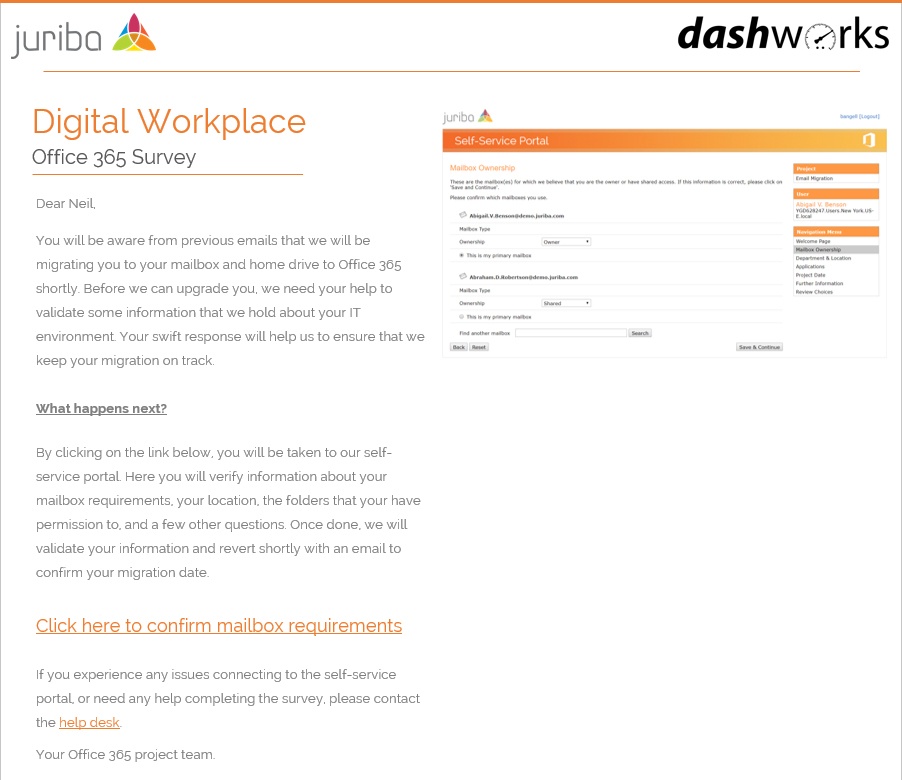
Generally, each life cycle upgrade project can easily translate to four to seven emails per user. If you have an estate of 25,000 users, this could mean anywhere between 100,000 to 175,000 emails that need to be sent and tracked. You will want to make sure your self-service and end user email communication work hand-in-hand, are part of your centralized command and control mechanism, and are as automated as possible — like you can with Juriba.
In some cases, we need to interface with third-party approval systems or service request systems. For a hardware refresh, for example, you can integrate with tools like ServiceNow to be able to action the data into the procurement systems and trigger approvals.
Naturally, the actual deployment will look very different for each Evergreen IT use case. It could be anything from a centrally-managed or self-service initiated in-place upgrade to a laptop replacement where employees have to physically come in. Depending on your use case, you will deploy using a push or a pull methodology to finish your cycle. Of course, during this process it is important that metrics are gathered on deployment progress and velocity to help to drive the future projects. After a successful deployment, you wrap up and start the cycle again.
Now that we have looked at the process from a very high-level theoretical point of view, let's look at the same process from a delivery perspective. The process outlined below follows the best practices outlined above, but the added details around how to implement it with actual tooling often makes it more realistic and therefore achievable. While you can plan the process in a linear fashion using an adapted Waterfall project management methodology, the process lends itself perfectly to using Agile!
Generally, an Agile process has a planning, building, testing, and reviewing component before launching into the next iteration. The exact names and number of steps depend on which Agile concept you choose. The graphic below visualizes an enterprise Evergreen IT deployment process using Juriba and the Agile methodology.
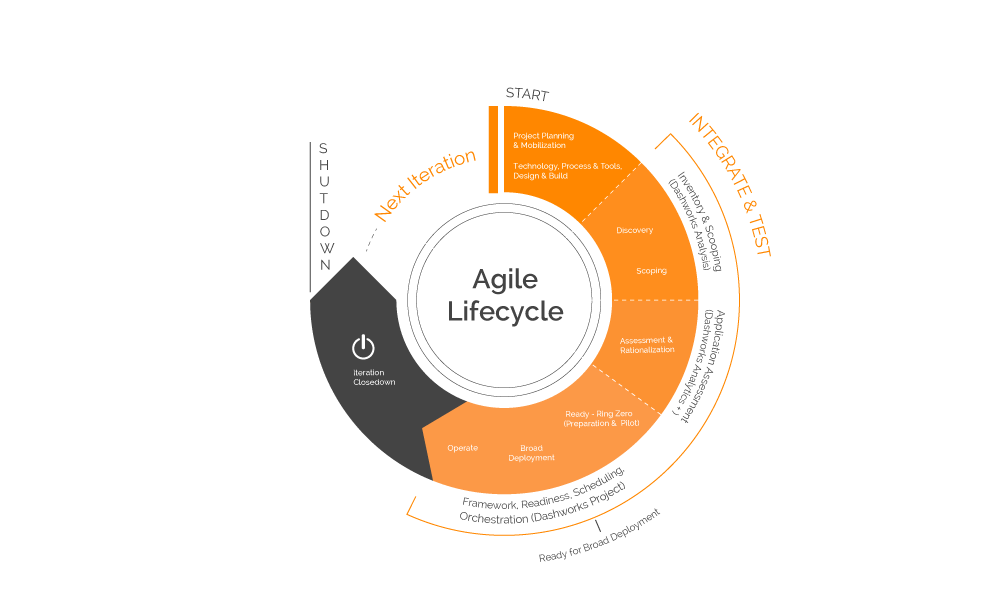
If you are struggling with managing Windows 10 Servicing or simply want to go through an end-to-end process in detail. check out our article on how to use Juriba to achieve maximum velocity upgrades.
Let's go through each phase in detail:
The first thing you will have to do is gather all of your relevant in-scope data. Depending on the use case, this can be user, device, application, life cycle, business unit, and/or location data from various sources. You aggregate this data from various sources, such as your Active Directory, SCCM, ServiceNow, HR feed, and others.
Using Juriba's certified connectors, you can collate and aggregate this data within minutes to a central data warehouse. This gives you the ability to drill down into detailed information, e.g., the deployment ring, RAG status, or application owner, as well as apply custom fields or add additional data points, such as locations and department.
Depending on which Evergreen IT upgrade cycle you are working on, you can define the scope by building a dynamic list of the relevant devices, apps, or users by setting some data filters aligned to your criteria for inclusion — e.g., all computers running version 1903 or below of Windows 10, all laptops with warranty expiring within the next 90 days, or all mobile devices running iOS 13.
For maximum velocity and efficiency, it is important to validate and rationalize the gathered information, check for any data quality issues, and exclude anything that is not relevant or applicable for this round. This eliminates any unnecessary noise factors that are irrelevant to the project but would slow down your progress.
Juriba makes this easy as it provides the ability to quickly filter, drill-down, and select appropriate data sets to work with.
-1.jpg?width=967&height=417&name=Dashworks%20-%20Windows%2010%20Branch%20Information%20(Blog%20Screenshot%20I)-1.jpg)
Evergreen IT Management is all about creating repeatable, scalable processes. With Juriba, creating and setting up a new project, as well as onboarding in scope assets, are extremely simple tasks. If you have already used Juriba for other related projects like, for example, your initial Windows 10 migration, you reuse most of the setup work. In addition, baked-in templates and industry best practices provide you with a proven and scalable process right out of the box.
To create your project, simply create your Evergreen IT workflow processes (e.g., your migration or upgrade paths), the tasks you want to track as well as any deployment teams and groups. Also, you can now create your user communication emails and set up your self-service portal. This is especially useful for Evergreen IT projects that lend themselves to a lot of user interaction, like a hardware refresh where your employees can choose their new devices from a predefined list.
Then customize the existing project template by changing the look and feel (to reflect your company branding) and the email content, and by making any additional customization you would like to make. Remember that your templates can be exported and cloned for future projects.
Now you are ready to put your project in motion. Your assets inherit the default readiness status which can be adjusted to suit your project's needs. Check for restricting factors such as application compatibility, hardware availability or possible delivery dates, or any other criteria that could hold up or slow down your project, and try to group your users or assets accordingly into appropriate rings. Remember: you are looking for the lowest hanging fruit that will allow you to migrate as many users, upgrade as many devices, or whatever KPI your use case has as quickly as possible.
Also, you can significantly accelerate your projects by using Juriba's Self Service capabilities to rationalize your applications, let employees volunteer for an upgrade, and other actions that would enable you to move faster. Now your scheduling team can kick off. Finally, create an onboarding list within seconds using Juriba's new smart list functionality. This list can be automatically onboarded into their default deployment rings or upgrade groups.
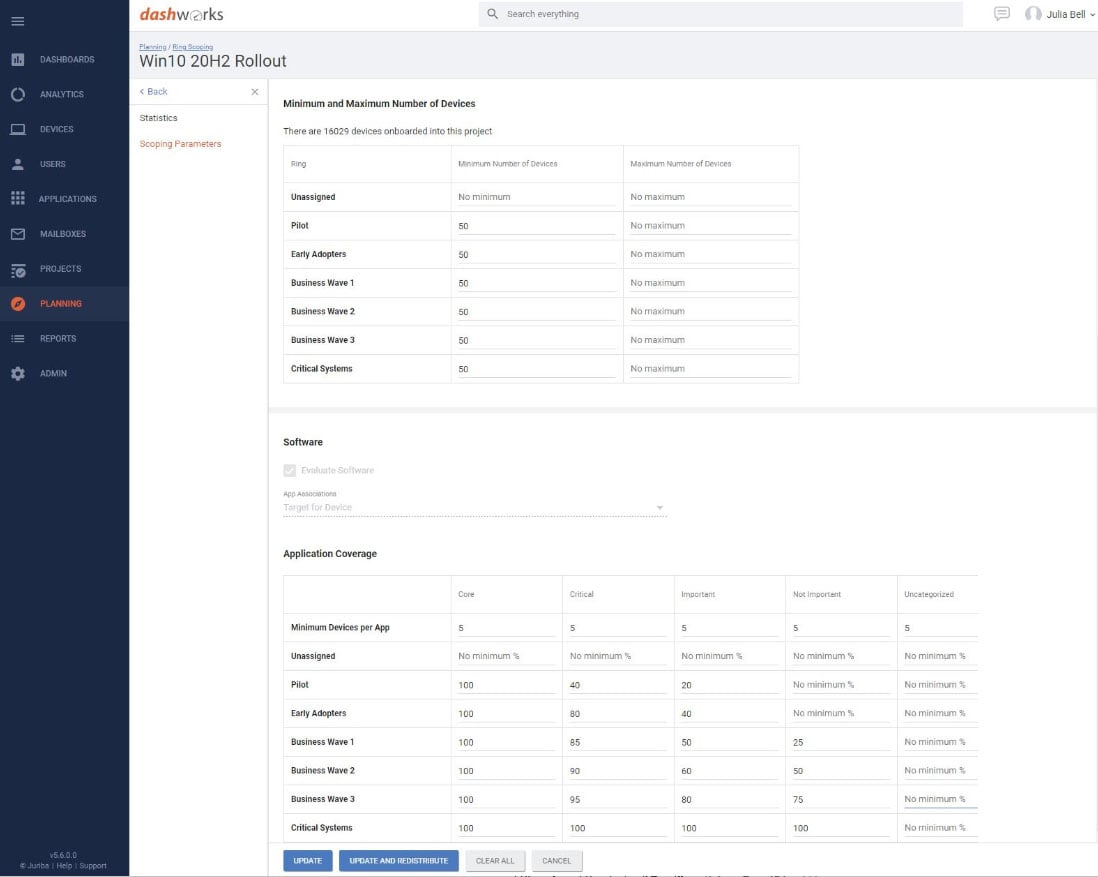
As you are moving objects (e.g., your users, devices, apps) towards a green status, you are making "how to move forward" decisions. This could be an in-place upgrade or replacement decision for an Evergreen use case. Now you also do any further testing, such as application compatibility testing with your business users.
For those Evergreen projects that contain application dependencies, application readiness can be accelerated using Juriba application manager automated smoke testing and packaging.
Through the self-service portal, you can significantly accelerate your Evergreen IT cycle by asking your users to further validate any important data points, confirm hardware choices, rationalize applications, and gather other crucial user input. Now you can trigger your deployment using SCCM or an equivalent desktop management tool. Using the Juriba dashboards, you can display real-time progress and bottlenecks that might need remediating or adjustments.
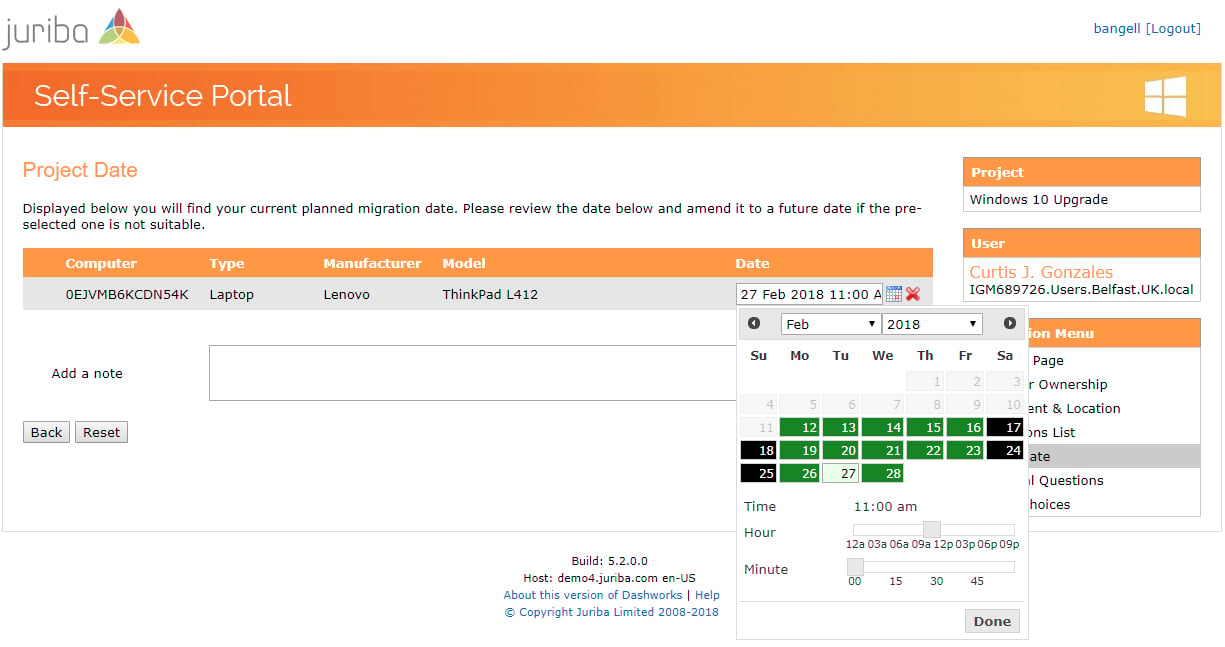
Your users' statuses are green and any issues are remediated — now it is time to deploy or roll out your project. Using Juriba's scheduling and capacity manager, you can plan your rollout waves by location and aim to achieve a zero-touch project. Engineer drop sheets and final emails to end users are generated by Juriba, and rollout events can be triggered, which get reported back into Juriba.
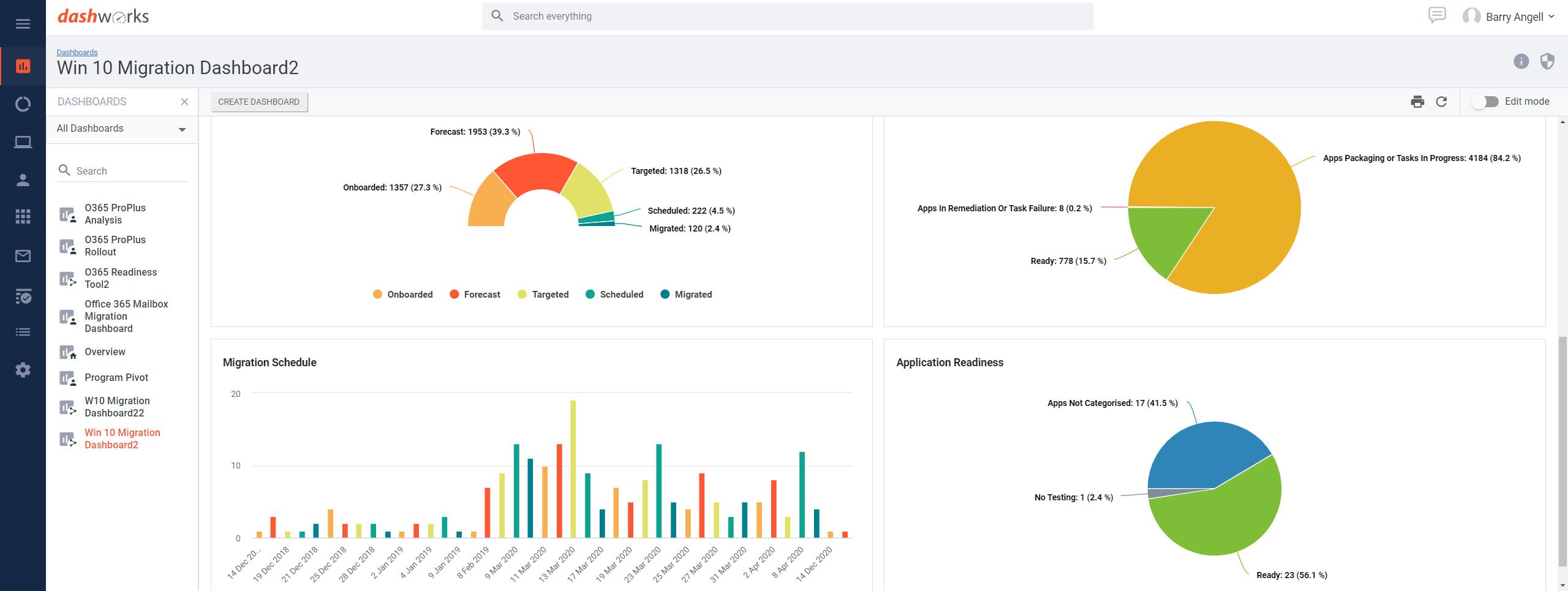
After your deployment or rollout is finished, don't forget to wrap up this cycle with all the required post-deployment clean-up tasks and shutdown your project (including all the final reporting, user training and signoff, process review meetings to improve the next iteration) and get ready for the next round.
The Juriba platform also offers Evergreen application lifecycle management: These solution are available as part of a Juriba module or as a stand-alone solution and can be run in the cloud or on premise. They encompasses three parts:
Due to the 24/7 zero-touch testing and the automation capabilities utilized, both Juriba Application Manager components offer 90% time savings compared to applications that manually package and test.
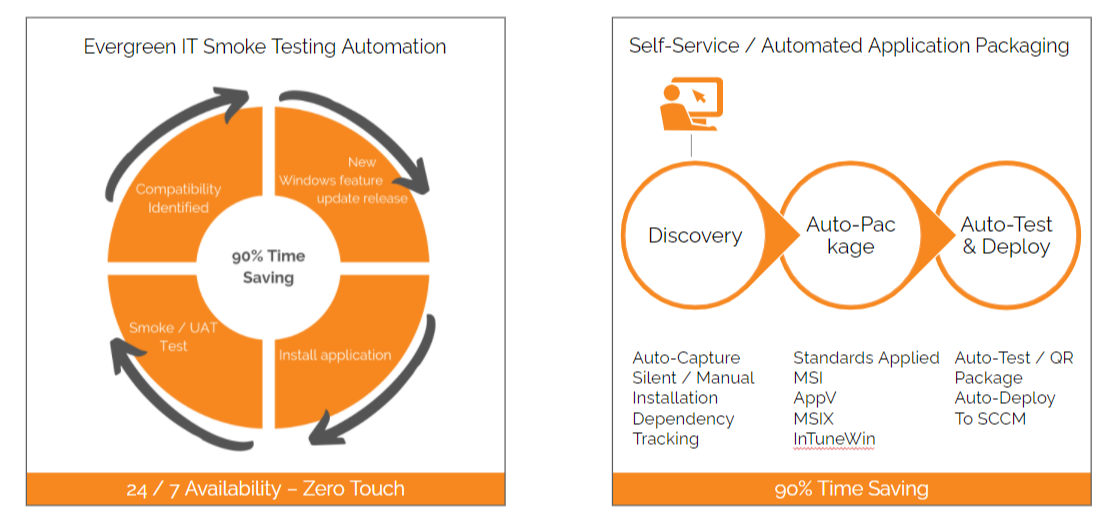
To illustrate how Juriba Application Manager can help you manage your Evergreen IT, let's walk through a real-world customer example where we were able to accelerate the application packaging process by more than 96% (namely from 91 hours to 53 minutes) by wrapping the traditionally disjointed process involving many back and forth into one tidy process.
Traditionally, the application owner submits a new application packaging request which then gets picked up by the initiation team who contacts the app owner to confirm the details of their submitted request. In the subsequent discovery process, the relevant source media and installation instructions are gathered and confirmed before the package is allocated to an app packaging factory team member.
Now the package can finally be packaged, readied for UAT, and sent back to the application owner. After about a week of UAT testing and communication between the app packaging factory owner and the app owner, the testing is complete, and the package can undergo quality review to ensure all packaging standards are met. Fifteen days after the initial request, the package can be readied for SCCM creation and finally deployed via SCCM. As you can see, the process is very stop-and-go, takes forever, and is resource intensive.
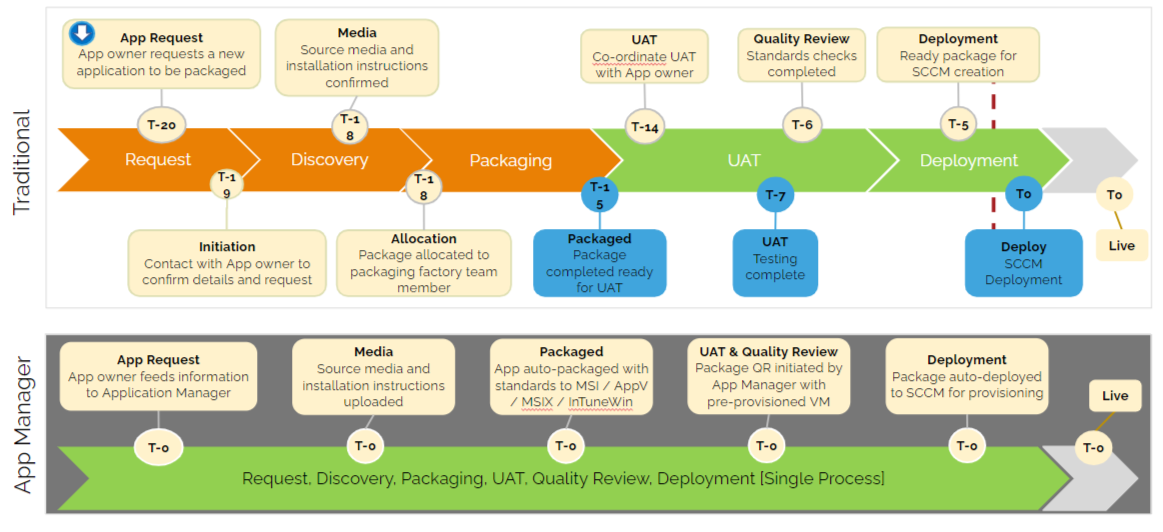
With Juriba Application Manager, the application owners submit their request by feeding the appropriate information to their standard request system, or directly within application manager. Immediately, source media and installation instructions can be uploaded, and the application can be auto-packaged (into MSI, AppV, MSIX, or IntuneWin) with the right packaging standards already applied. Once packaged, the package undergoes User Acceptance Testing (UAT) and quality review by the application owner utilizing pre-provisioned Virtual Machines (VMs). Lastly, the package is auto-deployed to SCCM for provisioning and goes live. This process in the above-mentioned customer example took an average of 53 minutes and involved only minimal back-and-forth as it is a single end-to-end process.
This automated packaging and testing process slots very nicely between the scoping and the automated ring management and readiness checks. This means, all in-scope applications are quickly run through automated smoke/functional tests to determine application compatibility. Any business critical apps that might require a manual sign-off then get spun out to undergo self-service UAT as an extra precaution. Any applications that require remediation or re-packaging, then go through the automated app discovery and packaging before being switched green, in addition to all the other apps that already reached that RAG status that then informs the ring assignment and readiness checks. This way, you are not only automating your packaging and testing in a silo but you're making it part of your entire Evergreen IT workflow.
Get started by finalizing your research, familiarizing yourself with the process, and getting executive buy-in to start building a business case. To help you with this process, watch our on-demand webinars
Juriba Acquires AppAvail For End-to-End App Packaging & Testing Automation
In addition, here are some other relevant resources that will make it easier for you to keep up with this ever-changing world (we update these resources on a regular basis):
Creating your own repeatable process is easy — because we did all the hard work for you. We created a fully customizable template (available in MS Project and as PDF), including over 700 action items, following Microsoft's recommended Windows 10 Deployment Ring concept and commonly used, proven industry practices. We based this template on our Windows 10 Project Plan, a plan that is successfully implemented by thousands of IT managers, and we adapted it based on our real-world Evergreen IT Management experience.
Although creating the right processes and ensuring that you have enough skilled resources is crucial, your Evergreen IT Management will not succeed without the right tooling. As you saw from the above described Juriba-led process, it is essential to have a centralized project management solution that not only provides your team with a live real-world view to create a single version of project truth, but also connects into all your relevant data sources and desktop management systems to be actionable. You will also need to be able to automate as much of the manual labor-intensive workload as possible, e.g., through automated communication and self-service.
Juriba's is THE Evergreen IT Management solution to make you succeed. Schedule your personalized product demo and let one of our experts show you how Juriba can solve your Evergreen IT problems.
Email: info@juriba.com